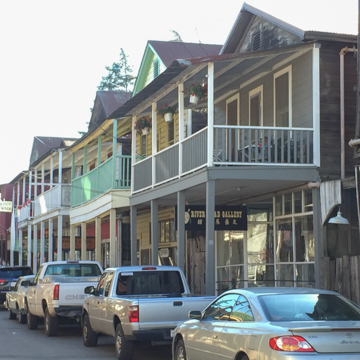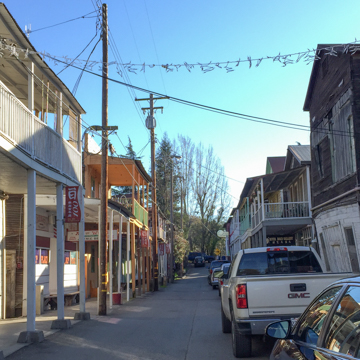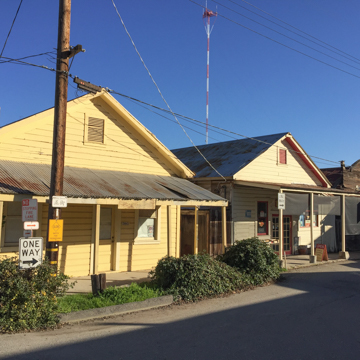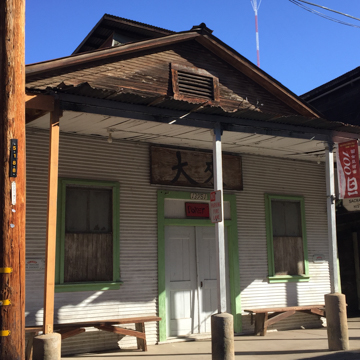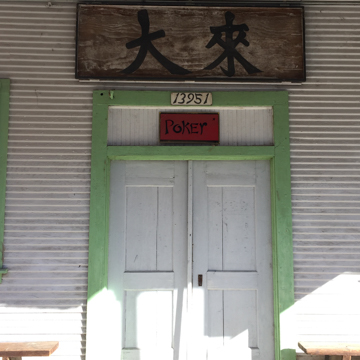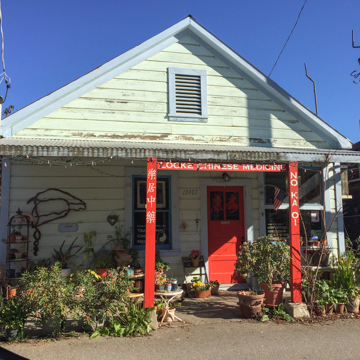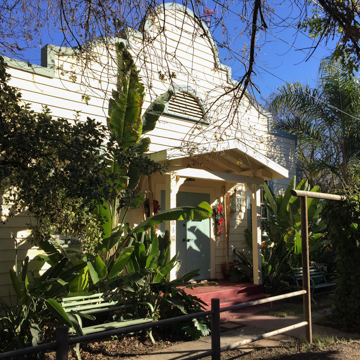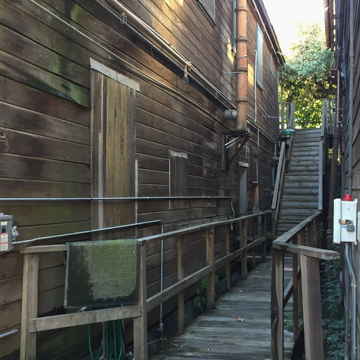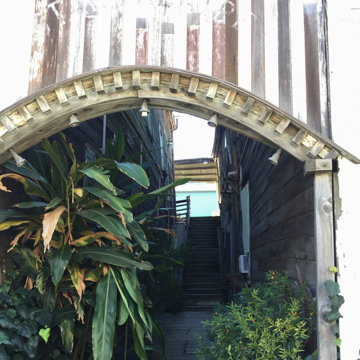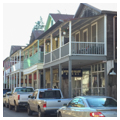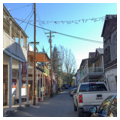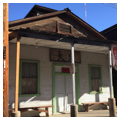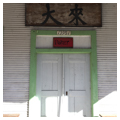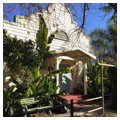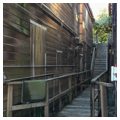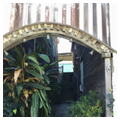Located in the rich agricultural region of California’s Sacramento River Delta, Locke’s Historic District is the most vibrant and enduring example of a rural Chinatown in the United States. The town of Locke occupies an area of approximately 14 acres on four streets laid out in a grid pattern, bordered on the west by the Sacramento River and on the north and east by an orchard and community gardens, approximately 28 miles south of Sacramento and 75 miles northeast of San Francisco. The Historic District corresponds to the town’s boundary and includes over 50 buildings, most of which were constructed between 1915 and 1917, when Chinese workers first moved to the new settlement.
Two-story structures along Main Street and River Road were constructed on rectangular lots, with wood frames, gable roofs, false fronts, clapboard or board-and-batten siding, and second-story balconies. Many of the buildings display evidence of ad hoc construction, including exterior plumbing pipes and corrugated metal roofs and awnings. During Locke’s heyday, commercial establishments—like the Yuen Lai Sing and Dai Loy gambling houses, the Wing Choy Owyung Rooming House, and the Yue Chong Market—operated in these buildings, which often served as residences for the business owners, their dependents, and renters. Commercial single-story buildings, like the Star Theater, which sometimes operated as a brothel and boardinghouse, reflect similar design. One-story dwellings, concentrated on Key Street and Levee Road on the town’s eastern and southern periphery, were constructed with wood frames, clapboard or board-and-batten siding, and gable roofs. Most were occupied by single families; however, during Locke’s early days, brothels also operated in some of these houses. Many of Locke’s buildings include Chinese architectural details and signage with Chinese elements that incorporate compound ideographs and signboard calligraphy, reflective of the town’s ethnic and cultural traditions.
Locke’s foundation and evolution is a testament to the struggles that Chinese immigrants endured in California as well as the group’s perseverance and gradual assimilation into American society. Cyclical demand for cheap labor during the second half of the nineteenth century conspired with nativist resentment, leading to various forms of racial oppression and vigilante violence against Chinese immigrants. In the early 1850s, unmarried males from Guangdong Province crossed the Pacific Ocean to seek their fortunes in the Gold Rush. Reflecting the prevailing nativist sentiment, the California State Legislature passed a series of anti-Chinese laws, beginning with the Foreign Miners Tax in 1850 and 1852, which sought to deter non-white miners. Declining opportunities in the gold fields coincided with the construction of the western portion of the transcontinental railroad. Chinese workers filled the demand for labor, and official anti-Chinese sentiment temporarily subsided. In 1868, the U.S. government ratified the Burlingame Treaty, which actively encouraged Chinese immigration. Once the railroad was completed, however, and demand for cheap labor declined, the U.S. Congress passed the Chinese Exclusion Act of 1882, essentially halting Chinese immigration. The legislation was renewed in 1892 and 1902, and was not repealed until 1943. A further blow to Chinese workers in California came in 1913, when the State Legislature enacted the Alien Land Law, which prevented non-citizen aliens from owning land. This legislation was not repealed until 1956. The Alien Land Law directly affected the residents of Locke, as they sought to build permanence into their lives with the construction of a rural Chinese community.
Aside from mining and railroad labor, Chinese immigrants also were drawn to agricultural pursuits. In the Sacramento region, this including the backbreaking work of dredging and reclaiming the silt-laden lands of the Delta as well as field and cannery work. By the end of the nineteenth century, Chinatowns had been erected in numerous settlements along the Sacramento River, including in Elliott Village, Courtland, Paintersville, Vorden, Walnut Grove, Isleton, and Rio Vista. In 1912, three buildings catering to Chinese workers were erected in Locke—formerly known as Lockeport—in an unincorporated area of Sacramento County, named for the property’s owner, George Locke. The settlement was the site of a small shipping port and packing shed served by the Southern Pacific Railroad. In 1915, after a fire destroyed the Chinatown in nearby Walnut Grove, leaders of the local Chinese community initiated construction of additional buildings in the settlement, financed with the capital of industrious Chinese merchants, and led by Bing Lee, a successful first-generation merchant and entrepreneur. The Walnut Grove Chinese inhabitants actually comprised two ethnic groups from neighboring regions in Southern China, who spoke distinct dialects. Ethnic tensions may have contributed to the decision to relocate to Locke or that decision may have been based more on economic considerations; however, it appears that the social relationship between the Chinese inhabitants of the two towns continued after the move. Lee negotiated the lease of nine acres of orchard land from George Locke in 1915. The details of the oral agreement skirted the intentions of the Chinese Exclusion Act, which denied the Chinese a means to becoming naturalized citizens, and the Alien Land Law, which required eligibility for citizenship as a prerequisite to property ownership. George Locke retained ownership of the land, but the Chinese residents owned the buildings they constructed on that land and paid rent only for the lots. According to the 1930 U.S. Federal Census, while most residents of Locke were renters paying $10 per month for a room, numerous dwellings were Chinese-owned and were worth between $500 and $1,000 each. The most valuable residence in town, valued at $5,000, was owned by George Locke’s son, Clay.
Locke’s cultural and historical significance lies in its unique status as a Chinese town that managed to maintain its ethnic identity and social composition from the time of its formation in 1915 until the 1960s, when the Chinese population began to decline. The 1930 Federal Census confirms Locke’s status as a predominantly Chinese town. However, Locke was also home to a significant multiethnic population of agricultural workers and their families from Spain, Portugal, Japan, Russia, Germany, Sweden, the Philippines, Canada, Scotland, Romania, Mexico, and Italy. After World War II, many of the second-generation Chinese residents of Locke chose to settle in larger cities where better employment opportunities existed away from the hardship of agricultural labor. By the 1960s, only elderly Chinese inhabitants remained.
Locke has the designation of being the last surviving rural Chinatown in the United States. Unlike other Chinatowns in the U.S., which were constructed as neighborhoods within towns and cities, Locke’s location in the Delta has left it little changed; indeed, the town retains much of its unique physical character. The area was designated an historic district in 1971, and a National Historic Landmark in 1990. Several restored buildings are home to the Dai Loy Gambling House Museum, the Locke Boarding House Museum, the Locke Chinese School Museum, and the Jan Ying Chinese Association Museum. All are open to the public.
References
Gillenkirk, Jeff, James Motlow, and Sucheng Chan. Bitter Melon: Inside America's Last Rural Chinese Town. Berkeley, CA: Heyday Books, 1997.
Leung, Peter C.Y., and L. Eve Armentrout Ma. One Day, One Dollar: Locke, California, and the Chinese Farming Experience in the Sacramento Delta. El Cerrito, CA: Chinese/Chinese American History Project, 1984.
Charleton, James H., “Locke Historic District,” Sacramento County, California. National Register of Historic Places Registration Form, 1990. National Park Service, U.S. Department of the Interior, Washington, D.C.










